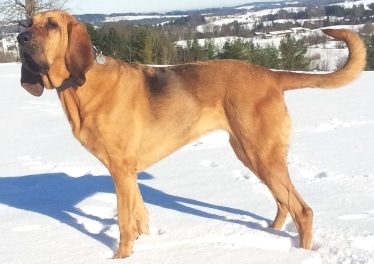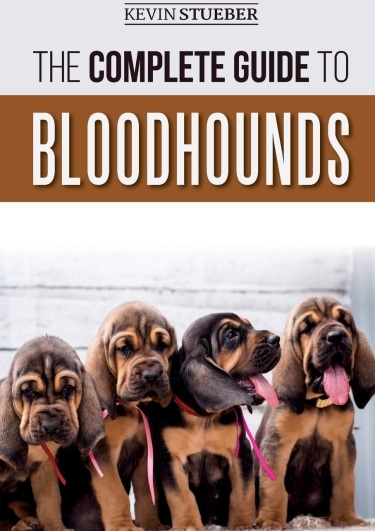
The modern Bloodhound has its origins in the Ardenne region of central Europe (Belgium/France border). It was there that the large game hounds of St. Hubert and Talbot and the white Southern hound were crossed to produce the dog known as the Chien de St. Hubert. Even today, in some countries, the terms Bloodhound and Chien de St. Hubert are interchangeable.
The Bloodhound possesses, to a most marked degree, every point and characteristic of those dogs that hunt together by scent (Sagaces). It is a very powerful dog, and stands over more ground than is usual with hounds of other breeds. Because of their hound heritage, Bloodhounds should never be allowed to roam free without supervision.
Height: The mean average height of adult Bloodhound dogs is 26″ (66cm), and of adult bitches 24″ (61cm). Dogs usually vary from 25″- 27″ ( 63.5-69 cm), and bitches from 23″- 25″ (58-63.5 cm); but, in either case, the greater height is to be preferred, provided that character and quality are also combined.
Weight: The mean average weight of Bloodhound adult dogs, in fair condition, is 90 lbs (41 kg), and of adult bitches 80 lbs (36 kg). Dogs attain the weight of 110 lbs (50 kg), and bitches 100 lbs (45.5 kg). The greater weights are to be preferred, provided that quality and proportion are also combined.
Coat Type: The Bloodhound’s coat is smooth, and the skin is thin to the touch and extremely loose, noticeably more about the head and neck, where it hangs in deep folds.
Temperament: The Bloodhound is extremely affectionate, and is not quarrelsome with companions nor with other dogs. Although somewhat shy, he is equally sensitive to kindness or correction by his master.
Health Problems: Hip dysplasia, as in all large breeds, must be a concern for the Bloodhound. Eye diseases and intestinal cancer are of concern as well. The Bloodhound is one of the breeds at risk for Gastric Torsion (bloat).
Special Interest: The first recorded use of Bloodhounds by organized law enforcement was in England in 1805, when the Thrapthon Association for the Prevention of Felons acquired a Bloodhound to search for poachers and thieves. Testimony of a Bloodhound’s man-trailing results is acceptable in almost every court of law. Their name “blood” hound has to do with their pure blood, as in a “blooded” hound, or one of pure ancestry, as opposed to being a blood tracker; whereas the Hanoverian and Bavarian Mountain Hounds both track for wounded animals, hence track the scent of blood.
Classifications:
AKC: Group 2 – Hounds
ANKC: Group 4 – Hounds
CKC: Group 2 – Hounds
FCI: Group 6 Section 1 Scenthounds
KC: Sporting – Hound Group
NZKC: Hounds
UKC: Scenthounds
Kennel.com Recommends Guide to Bloodhounds
Guide to Bloodhounds
 Kennel.com – Complete Guide to Dogs The Dog Lovers Guide
Kennel.com – Complete Guide to Dogs The Dog Lovers Guide